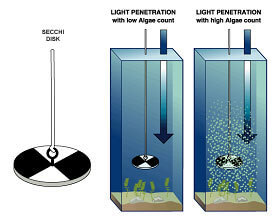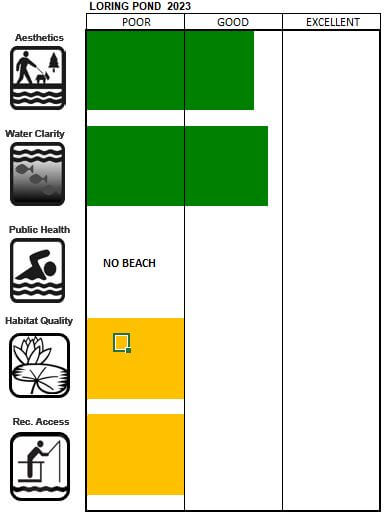Part of: Loring Park
Loring Pond is located in a small park on the edge of downtown Minneapolis. The Pond was created by connecting two small bodies of water – Jewett Lake and Johnson’s Pond. The smaller north basin was originally a wetland. There have been many water quality restoration projects over the years including: dredging, stormwater diversion, groundwater augmentation, shoreline restoration, aeration and installation of a liner and sealant on the lake bottom. There is a fishing/observation pier, many trails and a variety of recreation opportunities for visitors to enjoy. Loring does not have a swimming beach and was therefore not scored for public health.
Water Clarity
About Secchi Disk Readings
 To measure water transparency with a Secchi disk, the disk is lowered from the shaded side of a boat until it cannot be seen. The depth of the water is recorded at the point where the disk reappears upon raising it from its original depth beyond visibility. It is important to remember that the Secchi measurement is a simple, approximate measurement of water clarity and can be influenced by various factors such as time of day, reader’s eyesight, water color and suspended particles in the water. Therefore, Secchi disk readings should be used as a comparative tool to determine trends between lakes and over time.
To measure water transparency with a Secchi disk, the disk is lowered from the shaded side of a boat until it cannot be seen. The depth of the water is recorded at the point where the disk reappears upon raising it from its original depth beyond visibility. It is important to remember that the Secchi measurement is a simple, approximate measurement of water clarity and can be influenced by various factors such as time of day, reader’s eyesight, water color and suspended particles in the water. Therefore, Secchi disk readings should be used as a comparative tool to determine trends between lakes and over time.
- Increased water clarity may be due to reduced nutrient inputs, seasonal algal cycles, decreased sediment inputs, and zooplankton grazing on algae.
- Decreased water clarity may be due to large algal blooms, increased soil erosion inputs, wind circulation of sediments and nutrients, stormwater inputs, or a decrease in zooplankton.
Secchi readings for the lakes are done during the regular lake sampling schedule, with some lakes sampled every other year. Current Secchi readings taken during lake sampling can be found on the Lake Water Quality Map.
LAURI
Lake Aesthetic and User Recreation Index (LAURI)

The Lake Aesthetic and User Recreation Index (LAURI) was designed to give recreational users an easily understandable graphical source of information about conditions affecting their use of city lakes. The goal is to have an accurate, science based and easily understandable recreational indicator for the public. The LAURI has the five following indices: aesthetic considerations, water clarity, public health, habitat quality, and recreational access. For each of the five indices, the LAURI calculates a value that is then considered poor, good, or excellent.







